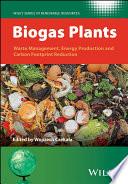BiogasPlants
Editedby
WOJCIECHCZEKAŁA
Pozna ´ nUniversityofLifeSciences,Poland
Tomymotherandfather,whoneverstoppedbelievinginme. Tomywifeforunderstandingmebetterthaneveryone. Tomysons,whofillmyheartwithjoyeachandeveryday.
ListofContributorsxvii
SeriesPrefacexxi
1AnaerobicDigestionProcessandBiogasProduction1 LiangliangWei,WeixinZhao,LikuiFeng,JianjuLi,XinhuiXia,HangYu, andYuLiu
1.1Introduction1
1.2BasicKnowledgesofADProcessesandOperations2
1.2.1FundamentalMechanismsandTypicalProcessesofAD2
1.2.2FactorsAffectingtheADProcessofBiogasProduction4
1.2.2.1Temperature4
1.2.2.2pH5
1.2.2.3OrganicLoadingRate(OLR)5
1.2.2.4Carbon–NitrogenRatio5
1.2.2.5Inoculum-to-SubstrateRatio(ISR)6
1.2.2.6SolidsConcentration6
1.2.2.7HydraulicRetentionTime(HRT)6
1.3CurrentChallengesofADProcessandBiogasProduction7
1.3.1AmmoniaInhibition7
1.3.2VolatileFattyAcidInhibition10
1.3.3PsychrophilicTemperatureInhibition12
1.4ProposedStrategiesforEnhancedBiogasProduction14
1.4.1PromotingDirectInterspeciesElectronTransfervia ConductiveMaterialsAdditive14
1.4.2Co-digestionofDifferentSubstrates16
1.4.3Bioaugmentation19
1.4.4BioelectrochemicalSystem-AssistedAD20
1.5Techno-EconomicandEnvironmentalAssessmentofAnaerobic DigestionforBiogasProduction22
1.5.1Techno-EconomicAnalysis22
1.5.2EnvironmentalFeasibilityandBenefitAssessment24 References26
2PretreatmentofLignocellulosicMaterialstoEnhanceBiogasRecovery37 JonathanT.E.Lee,NalokDutta,To-HungTsui,EeY.Lim,YanjunDai,and YenW.Tong
2.1Introduction37
2.1.1LignocellulosicWasteMaterialProduction38
2.1.2StructuralInsightofLignocellulosicMaterials39
2.1.3BiogasProductionfromLignocellulosicMaterialsandthe NeedforPretreatment40
2.2AvailablePretreatmentTechnologiesforLignocellulosicMaterials andtheCorrespondingBiogasRecoveryAssociated41
2.2.1PhysicalPretreatment41
2.2.1.1Comminution43
2.2.1.2MicrowaveThermalPretreatment43
2.2.1.3Extrusion44
2.2.1.4Ultrasonication45
2.2.2ChemicalPretreatment45
2.2.2.1AcidHydrolysisPretreatment45
2.2.2.2AlkaliHydrolysisPretreatment47
2.2.2.3IonicLiquidsPretreatment48
2.2.2.4DeepEutecticSolventsPretreatment48
2.2.2.5OrganosolventsPretreatment49
2.2.3BiologicalPretreatment49
2.2.3.1EnzymaticPretreatment50
2.2.3.2Whole-cellMicrobialPretreatment51
2.2.3.3FungalPretreatment52
2.2.3.4Ensiling52
2.2.3.5SummaryofIndividualPretreatmentEfficiencies53
2.2.4PhysiochemicalPretreatmentofLignocellulosicBiomassin theProductionofBiogas54
2.2.4.1HybridStateofArtLignocellulosicPretreatments54
2.3PertinentPerspectives58
2.3.1IntegratedBiorefineryWhileTreatingVariousWastes58
2.3.1.1MunicipalSolidWaste(MSW)58
2.3.1.2ForestryWaste59
2.3.1.3CropStraw59
2.3.2BiogasProductionfromLignocellulosicWasteandIts EconomicViability59
2.4Conclusions60 Acknowledgments61 References61
3BiogasTechnologyandtheApplicationforAgriculturalandFoodWaste Treatment73
WeiQiao,SimonM.Wandera,MengmengJiang,YapengSong,and RenjieDong
3.1DevelopmentofBiogasPlants73
3.1.1AgriculturalWaste74
3.1.1.1LivestockandPoultryManure74
3.1.1.2CropStraw74
3.1.2MunicipalSolidWaste75
3.1.2.1MunicipalSolidWaste75
3.1.2.2SewageSludge75
3.2AnaerobicDigestionProcess76
3.3BiogasProductionfromLivestockandPoultryManure77
3.3.1SuccessfulADofCattleandSwineManure77
3.3.1.1Industrial-scaleADofCattleManure77
3.3.1.2Industrial-scaleADofSwineManure77
3.3.2SuccessfulAnaerobicDigestionofChickenManureina LargePlant77
3.3.3StrategiesforMitigatingAmmoniaInhibitioninChicken ManureAD78
3.3.3.1SupplementationwithTraceElements78
3.3.3.2In-situAmmoniaStrippingforChickenManure Digesters79
3.4FoodWasteAnaerobicDigestion79
3.4.1ChallengesofFoodWasteADandtheSolutions79
3.4.1.1VFAsAccumulationinThermophilicADofFood Waste79
3.4.1.2ADTechnologiesforFoodWaste80
3.4.1.3AnaerobicMembraneBioreactorTechnologyfor FoodWaste81 References81
4BiogasProductionfromHigh-solidAnaerobicDigestionofFoodWaste andItsCo-digestionwithOtherOrganicWastes85 LeZhang,To-HungTsui,Kai-CheeLoh,YanjunDai,JingxinZhang,and YenWahTong
4.1Introduction85
4.2ReactorSystemsforHSAD86
4.2.1High-solidAnaerobicMembraneBioreactor86
4.2.2Two-stageHSADReactorSystem87
4.2.3High-solidPlug-flowBioreactor88
4.3IntensificationStrategiesforHSAD89
4.3.1High-solidAnaerobicCo-digestion(HS-AcD)89
4.3.2SupplementationofAdditives90
4.3.3BioaugmentationStrategiesforHSAD91
4.3.4OptimizationofProcessParameters91
4.4MicrobialCommunitiesforHSAD93
4.5DigestateManagementforHSAD94
4.6ConclusionsandPerspectives94 Acknowledgments95 References95
6.12.3FerricChlorideInjection129
6.12.4BiologicalMethod130
6.13DifferentApproachesforMoistureReduction130
6.13.1CompressionorCondensation130
6.13.2Adsorption130
6.13.3Absorption130
6.14SiloxaneRemoval131
6.14.1GasDrying131
6.15CO2 Separation132
6.15.1CryogenicTechnique132
6.15.2WaterScrubber133
6.15.3Adsorption133
6.15.4MembraneSeparation134
6.16Conclusion135 References136
7DigestatefromAgriculturalBiogasPlant–PropertiesandManagement141 WojciechCzekała
7.1Introduction141
7.2DigestatefromAgriculturalBiogasPlant–Production,Properties, andProcessing142
7.2.1Production142
7.2.2Properties142
7.2.3Processing144
7.3DigestatefromAgriculturalBiogasPlant–Management145
7.3.1RawDigestateFertilization145
7.3.2LiquidFractionManagement146
7.3.3SolidFractionManagement147
7.3.4EnergyManagementoftheSolidFraction149
7.4Conclusion150 References150
8EnvironmentalAspectsofBiogasProduction155 YelizavetaChernysh,ViktoriiaChubur,andHynekRoubík
8.1Introduction155
8.2ImpactofFarmsandLivestockComplexesontheEnvironment157
8.3TheEnvironmentalBenefitsofBiogasProduction158
8.4EnvironmentalSafetyoftheIntegratedModelofBioprocessesof HydrogenProductionandMethaneGenerationintheStagesof AnaerobicFermentationofWaste162
8.5LifeCycleAssessmentforBiogasProduction165
8.6EnvironmentalIssueofBiogasMarketinUkraine–CaseStudy167
8.7Conclusion172 References172
9HybridEnvironmentalandEconomicAssessmentofBiogasPlantsin
IntegratedOrganicWasteManagementStrategies179 AmalElfeky,KaziFattah,andMohamedAbdallah
9.1Introduction179
9.2Methodology180
9.2.1Overview180
9.2.2WasteManagementScenarios181
9.2.3LifeCycleAssessment182
9.2.3.1GoalandScopeDefinition182
9.2.3.2InventoryAnalysis183
9.2.3.3ImpactAssessment183
9.2.3.4Interpretation184
9.2.4LifeCycleCosting184
9.2.5Eco-EfficiencyAnalysis185
9.2.6CaseStudy:TheUAE185
9.3ResultsandDiscussion185
9.3.1MaterialandEnergyRecovery186
9.3.2LifeCycleAssessment188
9.3.2.1OverallImpactAssessment188
9.3.3LifeCycleCosting190
9.3.3.1CostandRevenueStreams190
9.3.3.2NetPresentValue191
9.3.4Eco-EfficiencyAnalysis192
9.4Conclusion193 References193
10ReductionoftheCarbonFootprintinTermsofAgriculturalBiogas Plants195 AgnieszkaWawrzyniak Acronyms195 10.1Introduction196
10.1.1ManureManagementandBiomethanePotentialinPoland andEUCountries196
10.1.2SubstratesUsedforBiogasPlantsinPoland196
10.1.3GHGEmissionsfromAgricultureandBiogasPlantsasTool foritsReduction198
10.2MethodologyofCF201
10.2.1GHGFluxesfromAgricultureandToolsforits Calculations202
10.2.2SystemBoundariesforBiogasPlantandDataCollection203
10.3LifeCycleCO2 FootprintsofVariousBiogasProjects–Comparison withLiteratureResults204
10.4Conclusions207 References207
11FinancialSustainabilityandStakeholderPartnershipsofBiogasPlants211 To-HungTsui,LeZhang,JonathanT.E.Lee,YanjunDai,andYenWahTong 11.1Introduction211
11.2BasicTechnologicalFactors212 11.3EconomicEvaluationandFailures214
11.3.1InvestmentRisksforFixedAssets214
11.3.2FailuresandIntervention215
11.4StakeholdersPartnershipandCo-governance216
11.4.1Government216
11.4.2ConsultantandConstructor216
11.4.3SourceofWasteStreams217 11.4.4CustomersforEnergyandResource217 11.5SummaryandOutlooks217 Acknowledgments218 References218
12MeasuringtheResilienceofSupplyCriticalSystems:TheCaseofthe BiogasValueChain221
RaulCarlssonandTatianaNevzorova 12.1Introduction221 12.2Background222 12.3Methodology223
12.4MeasurementScheme224
12.4.1IntroductiontotheMeasurementConcept224
12.4.2MeasuringManagementSystemResilience227
12.4.3MeasuringtheResilienceofPhysicalResourcesandAssets229
12.4.4TotalSystemResilience230
12.4.5ApplyingtheSystemResilienceModeltotheBiogasValue Chain231
12.4.5.1AnalysisofTwoSupplyChainsWithout Disruptions231
12.4.5.2DisruptingScenarioswithParametrizedResilience Functions233
12.4.5.3AnalysisofTwoSupplyChainswithDisruptions234 12.5ConclusionandRecommendations239 References240
13TheoryandPracticeinStrategicNichePlanning:ThePolish BiogasCase243 SteliosRozakis,KaterinaTroullaki,andPiotrJurga 13.1Introduction243
13.1.1ThePromisingPotentialofBiogasTransitioninCentral EasternEuropeanCountries243
14.3SocialAcceptabilityofAgriculturalBiogasPlants285
14.3.1FearofSomethingNew286
14.3.2ConcernsAboutUnpleasantOdors286
14.3.3ConcernsAboutContaminationofSoilsandGroundwater WhenUsingDigestateasFertilizer286
14.3.4ConcernsAboutDecliningPropertyValuesAroundBiogas Plants287
14.3.5ConcernsAbouttheDestructionofAccessRoads287 14.4Conclusion287 References288
15PracticesinBiogasPlantOperation:ACaseStudyfromPoland291 TomaszJasi ´ nski,JanJasi ´ nski,andWojciechCzekała 15.1Introduction291
15.2LegalAspectsRelatedtoRunningaBusinessintheFieldofBiogas ProductionandWasteManagement292
15.2.1IntegratedPermitorWasteProcessingPermit293
15.2.2ApprovalofthePlantbyVeterinaryServicesfortheDisposal ofWasteofAnimalOrigin294
15.2.3PermittoPlaceDigestateontheMarket295
15.2.4PermittoIntroducetotheElectricityDistributionNetwork296
15.3BiogasPlantComponents:ACaseStudyfromPoland297
15.3.1HallforReceivingandProcessingSlaughterhouseWaste297
15.3.2SubstrateStorageYard297
15.3.3SolidSubstrateDispenser297
15.3.4ReceivingBufferTankforLiquidSubstrates298
15.3.5SolidSubstrateBufferTank298
15.3.6MixingBufferTank298
15.3.7BufferandMixingTank298
15.3.8TechnologicalSteamGenerator298
15.3.9MainPumpingStation299
15.3.10First-stageFermentationTanks299
15.3.11Second-stageFermentationTank(3900m3 )withBiogas Tank(1800m3 )300
15.3.12CondensingCircuit301
15.3.13BiogasRefiningSystem301
15.3.14CogenerationModules301
15.3.15DigestateStorageReservoirs301
15.3.16BiogasTorch302
15.3.17Biofilter302
15.4FunctioningofaBiogasPlantProcessingProblematicWaste:ACase StudyfromPoland302
15.4.1SearchingandObtainingSubstrates303
15.4.2Receiving,Storage,andProcessingoftheSubstrate,Feeding ofRawMaterials304
15.4.3EnergyProductionandBiogasManagement305
15.4.4DigestateManagement306
15.4.5ManagementofanAgriculturalBiogasPlant307
15.5Summary308
ListofContributors
MohamedAbdallah DepartmentofCivilandEnvironmentalEngineering,Universityof Sharjah,Sharjah,UnitedArabEmirates
MuhammadArslan DepartmentofEnergySystemsEngineering,Universityof Agriculture,Faisalabad,Pakistan
RaulCarlsson CertificationDevelopmentUnit,RISEResearchInstitutesofSweden, Jönköping,Sweden
YelizavetaChernysh FacultyofTropicalAgriSciences,DepartmentofSustainable Technologies,CzechUniversityofLifeSciencesPrague,Suchdol,Czechia DepartmentofEcologyandEnvironmentalProtectionTechnologies,FacultyofTechnical SystemsandEnergyEfficientTechnologies,SumyStateUniversity,Sumy,Ukraine
ViktoriiaChubur FacultyofTropicalAgriSciences,DepartmentofSustainable Technologies,CzechUniversityofLifeSciencesPrague,Suchdol,Czechia DepartmentofEcologyandEnvironmentalProtectionTechnologies,FacultyofTechnical SystemsandEnergyEfficientTechnologies,SumyStateUniversity,Sumy,Ukraine
WojciechCzekała DepartmentofBiosystemsEngineering,Pozna ´ nUniversityofLife Sciences,Pozna ´ n,Poland
YanjunDai EnergyandEnvironmentalSustainabilityforMegacities(E2S2)PhaseII, CampusforResearchExcellenceandTechnologicalEnterprise(CREATE),Singapore SchoolofMechanicalEngineering,ShanghaiJiaoTongUniversity,Shanghai,China
RenjieDong CollegeofEngineering,ChinaAgriculturalUniversity,Beijing,China
NalokDutta DepartmentofBiochemicalEngineering,UniversityCollegeLondon, London,UK
BioproductsSciencesandEngineeringLaboratory,WashingtonStateUniversity,USA
AmalElfeky DepartmentofCivilandEnvironmentalEngineering,UniversityofSharjah, Sharjah,UnitedArabEmirates
SteliosRozakis BiBELab,DepartmentofChemicalandEnvironmentalEngineering, TechnicalUniversityofCrete,Chania,Greece
AbidSarwar DepartmentofIrrigationandDrainage,UniversityofAgriculture, Faisalabad,Pakistan
YapengSong CollegeofEngineering,ChinaAgriculturalUniversity,Beijing,China
YenWahTong NUSEnvironmentalResearchInstitute,NationalUniversityof Singapore,Singapore
EnergyandEnvironmentalSustainabilityforMegacities(E2S2)PhaseII,Campusfor ResearchExcellenceandTechnologicalEnterprise(CREATE),Singapore DepartmentofChemicalandBiomolecularEngineering,NationalUniversityofSingapore, Singapore
KaterinaTroullaki BiBELab,DepartmentofChemicalandEnvironmentalEngineering, TechnicalUniversityofCrete,Chania,Greece
To-HungTsui NUSEnvironmentalResearchInstitute,NationalUniversityofSingapore, Singapore
EnergyandEnvironmentalSustainabilityforMegacities(E2S2)PhaseII,Campusfor ResearchExcellenceandTechnologicalEnterprise(CREATE),Singapore DepartmentofEngineeringScience,UniversityofOxford,Oxford,UK
SimonM.Wandera DepartmentofCivil,Construction&EnvironmentalEngineering, JomoKenyattaUniversityofAgriculture&Technology,Nairobi,Kenya
AgnieszkaWawrzyniak DepartmentofBiosystemsEngineering,Pozna ´ nUniversityof LifeSciences,Pozna ´ n,Poland
LiangliangWei StateKeyLaboratoryofUrbanWaterResourcesandEnvironment (SKLUWRE),SchoolofEnvironment,HarbinInstituteofTechnology,Harbin,China
XinhuiXia StateKeyLaboratoryofUrbanWaterResourcesandEnvironment (SKLUWRE),SchoolofEnvironment,HarbinInstituteofTechnology,Harbin,China
HangYu StateKeyLaboratoryofUrbanWaterResourcesandEnvironment (SKLUWRE),SchoolofEnvironment,HarbinInstituteofTechnology,Harbin,China
JingxinZhang EnergyandEnvironmentalSustainabilityforMegacities(E2S2) PhaseII,CampusforResearchExcellenceandTechnologicalEnterprise(CREATE), Singapore
China-UKLowCarbonCollege,ShanghaiJiaoTongUniversity,Shanghai,China
LeZhang NUSEnvironmentalResearchInstitute,NationalUniversityofSingapore, Singapore
EnergyandEnvironmentalSustainabilityforMegacities(E2S2)PhaseII,Campusfor ResearchExcellenceandTechnologicalEnterprise(CREATE),Singapore DepartmentofResourcesandEnvironment,SchoolofAgricultureandBiology,Shanghai JiaoTongUniversity,Shanghai,China
WeixinZhao StateKeyLaboratoryofUrbanWaterResourcesandEnvironment (SKLUWRE),SchoolofEnvironment,HarbinInstituteofTechnology,Harbin,China
1 AnaerobicDigestionProcess andBiogasProduction
LiangliangWei,WeixinZhao,LikuiFeng,JianjuLi,XinhuiXia, HangYu,andYuLiu
StateKeyLaboratoryofUrbanWaterResourcesandEnvironment(SKLUWRE),SchoolofEnvironment, HarbinInstituteofTechnology,Harbin,China
1.1Introduction
Theincreasingamountoforganicwastesworldwidehasbecomeproblematicformost countriesduetothecontinuousdeteriorationoflandandwaterconditions,whichposes seriousriskstothesafetyofourcommunity[1].Moreover,theimpropertreatmentofthese organicwastesmightleadtotheundesiredreleaseofhugegreenhousegases(GHGs)into theatmosphere[2,3].ItwasestimatedbytheIntergovernmentalPanelonClimateChange (IPCC)andUSEnvironmentalProtectionAgency(USEPA)thattheglobalanthropogenic methaneemissionfrommunicipalsolidwastes(MSWs)reached1077millionmetricton ofCO2 equivalentin2020andisexpectedtoincreaseby17%intheyear2030.Mitigation practiceshaveforcedglobalactiontoadoptatechnologythatcanaddressanthropogenic methaneemissions[4].Numerousavailablemitigationopportunitiescurrentlyincludethe treatmentoftheorganicportionofMSWinacontrolledfacilityandrecoveringmethaneas afuelforon-siteoroff-siteelectricitygeneration[5].
EnergygenerationfromtheMSWandtheotheralternativesourceswillbenefitclimate changemitigationandminimizethealarmsposedtotheenvironment[6].Therehas beenahighuptakeofrenewableenergytechnologies(RETs)worldwidetodealwith thedetrimentaleffectspausedbyfossil-relatedenergygenerationtechnologies.Fora purposeofincreasingtheenergyaccessibilitywhilesimultaneouslyrestrictingthe
BiogasPlants:WasteManagement,EnergyProductionandCarbonFootprintReduction, FirstEdition.EditedbyWojciechCzekała ©2024JohnWiley&SonsLtd.Published2024byJohnWiley&SonsLtd.
worldwidetemperatureincreasedwithin2 ∘ Cbefore2050,adoptionofRETsshouldbe highlyencouragedandraisedsignificantly.Thisgrowingimpetusforalternativeavenues forrenewableenergydemandstheconsiderationofdifferentfeedstocks,exploringofnovel techniques,andimprovementsofexistingtechnologies.
Bioenergyhasbeenregardedasthemostsubstantialrenewableenergysourceduetoits cost-effectiveadvantagesandgreatpotentialforsubstitutingnonrenewablefuels.Bioenergy derivedfrombiomassmaterials,suchasbiologicalorganicmatterobtainedfromplants oranimals,isrenewableandgreen.Generally,thosebiomassenergysourcesincludebut arenotlimitedtoterrestrialplants,aquaticplants,timberprocessingresidues,MSWs, animaldung,sewagesludge,agriculturalcropresidues,andforestryresidues.Undoubtedly, bioenergyisoneofthemostversatilerenewableenergiesbecauseitcanbemadeavailableinsolid,liquid,and/orgaseousforms.Differentavenuescanbeexploredtoharvest energyfrombiomassmaterials.Biomethanehasahighheatingvaluerangingbetween50 and55MJm 3 andalowheatingvaluerangingbetween30and35MJm 3 [7].
Anaerobicdigestion(AD)ispracticedextensivelyforthetreatmentofbiodegradable wasteforbiomethanegeneration[8].Thistechnologyhasthecapabilityofmanagingthe typicalorganicwastessuchasfoodwaste,lignocellulosicbiomassandresidues,energy crops,andtheorganicfractionofmunicipalsolidwaste(OFMSW)[9],anditsenvironmentallysoundfeaturesattractedworldwideattentionforbiogasproduction.ADisamicrobedriven,multiphase,andcomplexbiochemicalprocess,andfourtypicalbiochemicalphases suchashydrolysis,acidogenesis,acetogenesis,andmethanogenesisareinvolvedinits wholeprocess.Organicmattercouldbeefficientlymetabolizedbybacteriaandarchaea andfinallyconvertedintomethaneandcarbondioxide[10,11].However,ADprocesses arealwayslimitedbythreemainfactors:(i)hydrolysisofsubstratesistherate-limiting factorforthebioconversionphase;(ii)inefficientutilizationofkeyintermediatessuchas propionicandbutyricacid;(iii)slowgrowthofanaerobesofmethanogenesis[12],and finallyleadtoalowbiomethanerecoveryrateduringtheirpracticaloperation[13].Thus, theadvancementsintheADprocessarelargelyaimedtowardonegoal:improvingbiogas productionandrecovery.
ThereiscurrentlyconsiderablepotentialforbiogastechnologytobedevelopedasaRET thataddressesenergyandenvironmentalissues.Biogasisacriticaltechnologythatprovidesrenewableenergyfromprocessingavarietyofdigestiblebiomasstypes.Substrates suchasstraw,forestryresidues,animalandpoultrymanure,andotherorganicwastescan betreatedwithinADsystems.Thepurifiedbiomethanecanbeintegratedintoconventional fossilenergysupplysystemsandguaranteetheADtechnologyinenergytransformation andecologicalcivilizationconstruction.However,thebiogasindustryfacesmanychallenges,includinglowgasproductivity,shortbiogastanklife,highdeteriorationratesof digesters,difficultyindigestionresidueutilization,andlimitedeconomicbenefits[14,15]. Toimprovethebiogasandhighlightitsroleinenergyandenvironmentalproblem-solving, itisnecessarytodevelopnewapproachesforthepurposeofextendingtheindustrialchain andfurtherexploringnewmodelsthatcanpromotethecommercialization.
1.2BasicKnowledgesofADProcessesandOperations
1.2.1FundamentalMechanismsandTypicalProcessesofAD AD,fullmicrobiologicaldegradationprocessunderanaerobicconditions,representsone ofthemostpromisingprocessestoconvertdiverseorganicsubstrates(animalmanure,







